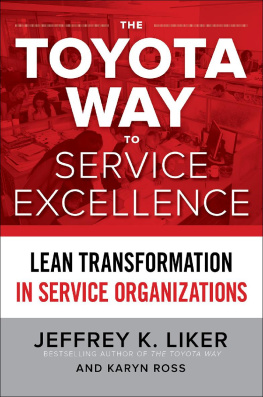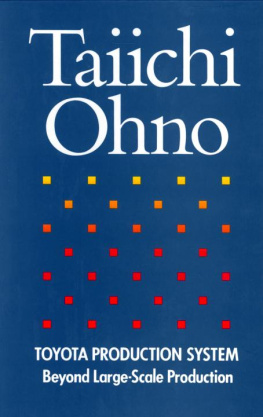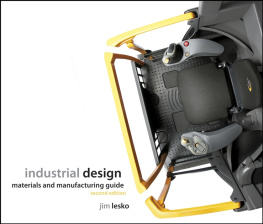Worker Leadership
Worker Leadership
Americas Secret Weapon in the Battle for Industrial Competitiveness
Fred Stahl
The MIT Press
Cambridge, Massachusetts
London, England
2013 Massachusetts Institute of Technology
All rights reserved. No part of this book may be reproduced in any form by any electronic or mechanical means (including photocopying, recording, or information storage and retrieval) without permission in writing from the publisher.
Library of Congress Cataloging-in-Publication Data
Stahl, Fred, 1937
Worker leadership : America's secret weapon in the battle for industrial competitiveness / Fred Stahl.
pages cm
Includes bibliographical references and index.
ISBN 978-0-262-01963-7 (hardcover : alk. paper)
ISBN 978-0-262-31728-3 (retail e-book)
1. ManagementEmployee participation. 2. Leadership. 3. Industrial productivity. 4. Industrial management. 5. Production management. I. Title.
HD5650.S64 2013
658.3152dc23
2013004756
10 9 8 7 6 5 4 3 2 1
d_r1
to Ed Stine, laborer, and Grant Stahl, entrepreneur
Foreword
Virtually all major corporations survey the engagement of their employees and evaluate managers not just on performance as seen by upper managers but also on the level of engagement of those working for them. Similarly, virtually every major corporation has some form of lean or Six Sigma initiative or some other continuous-improvement program. Appropriately, these initiatives seek to reduce variability, eliminate waste, and improve the flow of value to customers.
Fred Stahl asks whether this is the best we can do. For transformational performance, is it enough to have a highly engaged workforce and apply continuous-improvement tools and methods? Stahl delivers the answer loud and clear: No! Engagement alone is not enough. Lean or Six Sigma initiatives are not enough. They lack something crucial: a fundamental shift in the underlying assumptions about people at work that can result in significantly higher levels of enterprise productivity and job satisfaction.
Implicit in all the engagement surveys is the assumption, which dates back more than 50 years, that a motivated worker will be a productive worker. Hence, the focus is on how well managers are motivating the people who work for them. As Stahl demonstrates, however, the workers will not be fully committed to advancing the goals of the enterprise if the work itself isnt clearly connected to the fortunes of the enterprise. It is a bit like pushing on a string. Cause and effect are separated.
Another assumption, this one implicit in lean and Six Sigma initiatives dating back more than 25 years, is that continuous-improvement tools and methods can be engineered into business operations. This assumption compels experts to apply value stream maps and institute kaizen events to remove bottlenecks and improve efficiency. The very use of the term kaizen event is instructive. Kaizen translates roughly as continuous improvement based on knowledgenot something that can be a one-time event. As Stahl demonstrates, however, applications of lean or Six Sigma tools and methods are destined to be one-time events in the absence of Worker Leadership. Stahl turns the established thinking on its head by showing that productive workers are motivated workers. This is the premise underlying Worker Leadership. Rather than managing what is in workers minds (that is, trying to engage the workforce), managers redesign the organization and management of production to enable workers to exercise their natural inclination to improve things. The more productive workers make their own jobs, the more they like those jobs. Worker Leadership says Transfer control of production operations and processes to workers to maximize both productivity and job satisfaction. It overturns many of the operating assumptions of todays managers. It is not just a sharing of responsibility, but also a sharing of authorityof powerthat produces transformational outcomes.
Through the lens of Worker Leadership, major developments in the managerial literature can be reexamined. Consider the study that launched what came to be called the Human Relations movement: Fritz Roethlisbergers study of changes in the wire-harness assembly operations of Western Electrics Hawthorne Works. In addition to heightening awareness of how research studies can be interventions that become treatment variables (now known as Hawthorne effects), Roethlisbergers research showed performance gains as a result of paying attention to people. this was a revolutionary assumption.
Subsequent movements centering on socio-technical systemsquality of work life, employee involvement, quality circles, and so onall advanced this assumption with new and expanded ways to increase worker motivation. Along the waythough not always noticed in the way Fred Stahl has illuminatedthere were experiments and initiatives that went much further, involving various degrees of what we would now call Worker Leadership. The early scholars of socio-technical systems devoted most of their attention to issues of power in the workplace in relation to employee involvement, but that line of thinking was largely superseded in the management literature by a focus on participation and, more recently, engagement. Thus, the earlier evidence for the power of Worker Leadership wasnt fully understood.
For example, in the late 1970s and the early 1980s Shell Oils Sarnia refinery was operating without any managers on site. Autonomous teams of workers had full responsibility for scheduling and operating the facility. In retrospect, Worker Leadership helps us to see that this level of responsibility and shared power was very different from the weekly meeting of a quality circle in which management entertained employees suggestions for improvement.
Some of the earliest scholarship on high-commitment operations did document the importance of managers giving up control, in the way Dick Kleine demonstrated at John Deere.
Now consider a more recent example. In 2006, leaders from the UAW and representatives of corporate management visited nearly all of the Ford Motor Companys U.S. assembly, stamping, and engine plants a year before the 2007 national negotiations. In each case, the workers were assembled in a town hall meeting and were briefed on the business prospects for their particular mix of products. Informed by the business data, the participants negotiated competitive operating agreements in which potential gains from efficiency improvements were paired with potential new investments in products and technology. Over the preceding five years, all these facilities had taken part in accelerated implementation of the UAW-Ford Quality Operating System and Safety Operating System, putting lean or Six Sigma tools and methods into broad use. The sharing of responsibility for the business case with workers in their plants generated savings of more than $500 million from efficiency improvements. This, in turn, made possible investments that maintained jobs and expanded operations at a time when the auto industry and the nation were facing the greatest economic downturn since Great Depression.
In these cases and many others, the interactions went far beyond workers feeling high levels of engagement or engineers implementing lean or Six Sigma tools and methods. Yes, workers did feel engaged, and lean or Six Sigma methods were utilized, but in addition power and decision making were shared in ways that evidenced true Worker Leadership.
In retrospect, what looked to be particularly robust examples of employee involvement were actually something qualitatively different: examples of a shift in the fundamental underlying assumptions about peoples work behavior.
Fred Stahl, a former Boeing executive, was a founding contributor to MITs Lean Aircraft Initiative. It was on an LAI benchmarking trip that Fred first encountered Dick Kleine, who was achieving transformational results at John Deere. That was nearly 20 years ago. In the years since, Fred has been critically reflecting on what he saw and connecting it to many embedded assumptions about how business operates. As a contributor to the Lean Aircraft Initiative, I had periodic conversations with Fred; for more than a decade now, he has been advancing his thoughts on these matters. It has been a delight to see the ideas crystallize. Because of the degree to which they challenge received assumptions, that time has been necessary to trace the implications in full.
Next page









